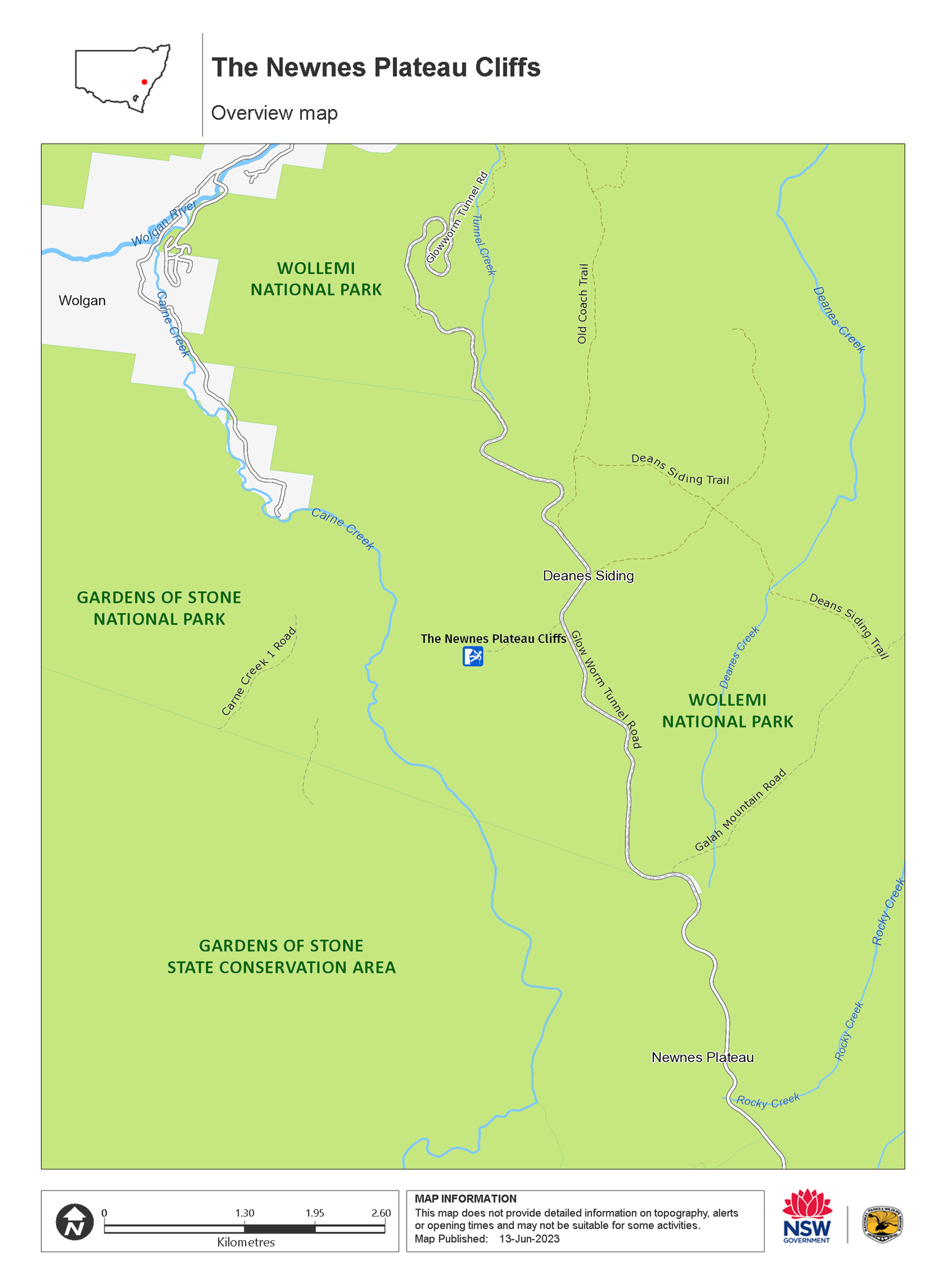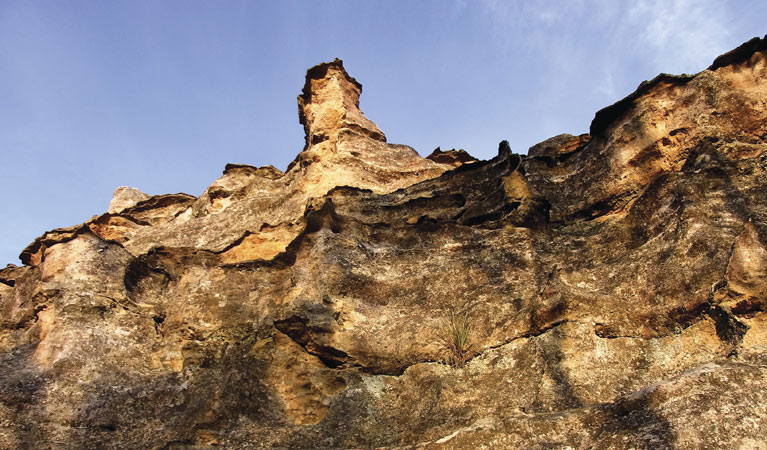Overview
For self-reliant walkers, climbers and mountain bikers, Newnes Plateau is a wonderland of challenging experiences and awe-inspiring views.
- Accessibility
- No wheelchair access
- Opening times
The Newnes Plateau cliffs are always open but sections may close due to poor weather or fire danger.
- What to
bring - Sunscreen, hat, drinking water, cooking water, topographic map, compass, gps
- Please note
- You’ll need to bring all provisions for your activity and overnight stays in Gardens of Stone National Park
- You should be an experienced walker, climber, canyoner or trail bike rider to undertake these activities at Newnes Plateau.
- Remember to take your binoculars if you want to birdwatch
This is the stuff adrenalin junkies’ dreams are made of. Whether your thing is bushwalking, canyoning, rock-climbing or mountain-biking, Newnes Plateau is an adventure wonderland.
While you’re here, you’ll catch breathtaking views of the meandering Wolgan River, the high mesas of Pantoneys Crown and Donkey Mountain, and the stunning rock formations that Gardens of Stone is famous for. Deep in the bush you’ll see a wonderful variety of habitats including alpine grasses and dwarf heath, and the magnificent eucalypts recognised by the area’s World Heritage listing. You’ll also enjoy a fantastic array of birdlife as well as kangaroos, wallabies, and gliders moving through the bush around you.
Map

Map legend

Local alerts
For the latest updates on fires, closures and other alerts in this area, see https://www.nationalparks.nsw.gov.au/things-to-do/adventure-sports-experiences/the-newnes-plateau-cliffs/local-alerts
Park info
- in Gardens of Stone National Park in the Sydney and surrounds region
Gardens of Stone National Park is always open but may have to close at times due to poor weather or fire danger.
Visitor info
All the practical information you need to know about The Newnes Plateau Cliffs.
Getting there and parking
Get driving directions
The Newnes Plateau Cliffs are in the southern precinct of Gardens of Stone National Park. To get there:
- From Lithgow, follow the State Mine Road northeast to join Gully Road.
- Continue onto Glow Worm Tunnel Road just past Bungleboori picnic area (State Forest area)
- Follow Glow Worm Tunnel Road through the pine plantations into Gardens of Stone National Park
- The Newnes Plateau Cliffs are located to the east with Wollemi National Park to the west
Road quality
- Unsealed roads
Vehicle access
- 2WD vehicles
Weather restrictions
- 4WD required in wet weather
Parking
There is no parking at The Newnes Plateau Cliffs but you can stop along Glow Worm Tunnel Road to explore the cliff edge; but take extra care – it is unfenced.
Best times to visit
There are lots of great things waiting for you in Gardens of Stone National Park. Here are some of the highlights.
Spring
Experience the wonder of the spring bird migrations and enjoy the flowering season for many of the plant species of the park.
Summer
Though you need to be prepared for hot weather, this can be a great time to explore the pagodas as deep shade falls between them and in the canyons, making for dramatic photographs.
Winter
The light in the mountains is beautiful in winter. Take crystal clear scenic photos from your vantage point on the cliff tops or just marvel at how far you can see from up here.
Weather, temperature and rainfall
Summer temperature
Average
8°C and 25°C
Winter temperature
Average
0°C and 9°C
Rainfall
Wettest month
January
Driest month
April
The area’s highest recorded rainfall in one day
135mm
Maps and downloads
Accessibility
Disability access level - no wheelchair access
Permitted
You’re encouraged to bring gas or fuel stoves, especially in summer during the fire season
Prohibited
Pets
Pets and domestic animals (other than certified assistance animals) are not permitted. Find out which regional parks allow dog walking and see the pets in parks policy for more information.
Smoking
NSW national parks are no smoking areas.
Learn more
The Newnes Plateau Cliffs is in Gardens of Stone National Park. Here are just some of the reasons why this park is special:
An adventurer's haven

If it's not enough to view the splendour of the park from your car or the picnic area, perhaps canyoning, mountain-biking National trail: Crown Creek fire trail, or climbing Pantoneys Crown or Donkey Mountain are more your style. Come well prepared into this remote and sometimes challenging country, or join one of the private tour companies that bring groups into the park.
- The Newnes Plateau Cliffs For self-reliant walkers, climbers and mountain bikers, Newnes Plateau is a wonderland of challenging experiences and awe-inspiring views.
Astonishing rock formations

The geological evolution of this park has produced Triassic Narrabeen sandstone cliffs, slot canyons, grand mesas and the beautiful, yet often strangely delicate, pagodas. These pagodas are formed by wind and rain shaping the Banks Wall and Burramoko sandstone layers that spread right across the Greater Blue Mountains Area World Heritage Property, and they range from quite small to over 60 metres in height. They are amazingly beautiful against the blue mountain sky.
- Baal Bone Gap picnic area Visit the jewel in the crown of Gardens of Stone and marvel at the magnificent rock pagodas, sheer cliffs and endless scenic views of Baal Bone Gap.
- National trail: Crown Creek fire trail For horseriding or mountain-biking, take Crown Creek fire trail. This iconic part of the east coast's National trail reveals staggering scenic views and a feeling of complete freedom.
- The Newnes Plateau Cliffs For self-reliant walkers, climbers and mountain bikers, Newnes Plateau is a wonderland of challenging experiences and awe-inspiring views.
Incredible biodiversity
Gardens of Stone National Park is part of the Greater Blue Mountains Area World Heritage Property. The Greater Blue Mountains was named a World Heritage Area for its astonishing biodiversity. It contains almost 100 species (or 13%) of eucalypts in the world. This is because of the great diversity of habitats and landscapes in the region. Plateaus, heaths, flat valley floors with varying exposures and fire histories produce the incredible range of plantlife growing in the park.
World-class bird watching

The diversity of the park supports a wonderful array of birdlife - this is an internationally-recognised bird watching area. You may see such threatened birds as the regent honeyeater, swift parrot, spotted harrier, square-tailed kite, turquoise parrot, lyrebird, and many more. Spring and autumn are the times to see the migrations across the sky. Walkers may also come across rare broad-headed snakes, Lesueur's gecko, heath monitors, brown antechinus, bush rats and occasional quolls. Brush-tailed rock wallabies can be seen along the caves and ledges, and the upland swamps in the eastern part of the park are home to giant dragonflies.

